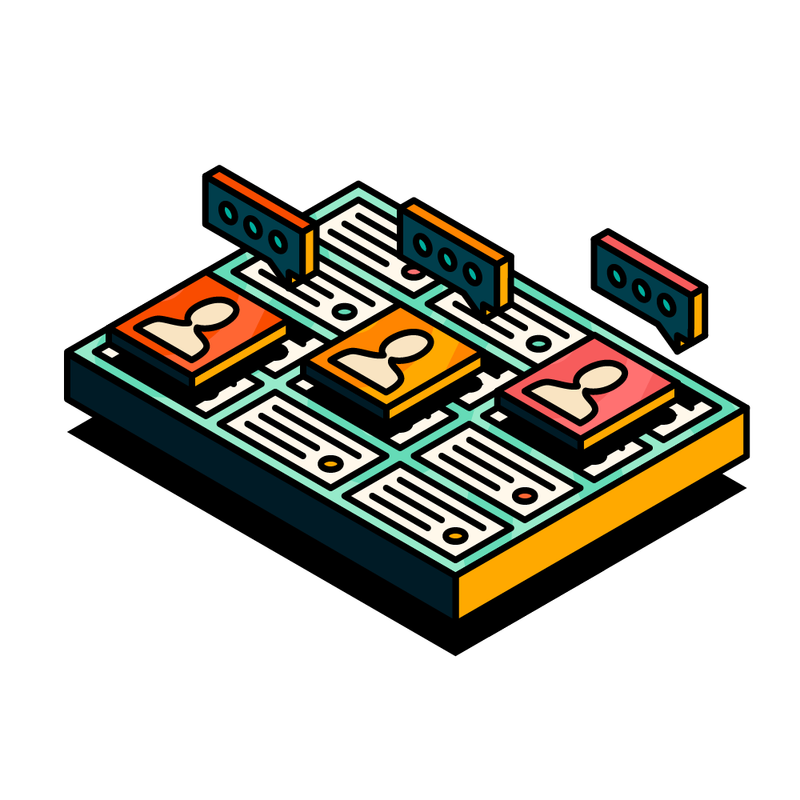How to create user stories in Jira
Share on socials
How to create user stories in Jira: all you need to know

Wilson Ong
Published on 15 August 2024
9 min read


Wilson Ong
Published on 15 August 2024
9 min read
Jump to Section
Jump to section
What is a user story?
How to create a user story in Jira
A Jira user story template to get you started
Setting your user story acceptance criteria
What about Jira user story mapping?
Keeping tabs on your user story backlog
How to manage user stories in complex projects
Learn how to craft Jira user stories that align your team, drive development, and deliver real value to your end-users—your roadmap to agile success starts here!
All great software starts with understanding your users. But, that's easier said than done!
Luckily, that's where user stories come in.
Your user stories capture the key reasons you're building new features and how you'll deliver value to your end-users.
In this guide, you'll learn how to craft Jira user stories that align your project team around your work to drive meaningful results.
Let's dive in.
Key takeaways:
- User stories are informal, end-user-focused explanations of software features that capture the value delivered to the end-user.
- A basic user story template follows the structure: 'I am a [type of user], and I want to do [activity/function] so that I can [achieve a specific goal]'.
- Good user stories are succinct, use plain language, and adhere to the INVEST criteria (Independent, Negotiable, Valuable, Estimable, Small, Testable).
- Acceptance criteria define how you determine a user story is complete and should be specific, measurable, and testable.
- Regular backlog grooming sessions are essential to keep user stories relevant, appropriately sized, and clearly described.
- Hierarchy for Jira allows you to visualise connections between user stories, epics, and initiatives, providing a clear overview of your priorities and upcoming work.
What is a user story?
Atlassian defines a user story as an 'informal, general explanation of a software feature written from the perspective of the end-user.'
The key here is the term 'end-user'. A user story should reflect the needs and wants of an individual—a system user, internal team member, or customer—and show how the requested functionality will deliver value to this end-user.
It's important to remember these stories are end goals, not features, and should be written in layman's terms. Anyone in the business should be able to read a story and understand what it means.
In Jira, stories become issues, which are project building blocks that represent bugs, tasks, and, of course, stories.
How to create a user story in Jira
To add a story to your backlog:
- Navigate to the 'Create' screen in your Jira Scrum or Kanban project.
- Create a new Jira issue and select the appropriate project from the dropdown menu.
- Make sure 'Story' is selected as the issue type. This is the default setting.
- Follow your organisation's guidelines for formatting your story. If you don't have guidelines, don't worry— we'll share an example below!
- Your brand new user story will then go into the backlog, ready to be assigned and actioned by the Project Manager, Project Leader, Product Owner, or other relevant stakeholders.

And that's it! Now, let's look at a user story template you can use to write easy-to-read descriptions that get your team on the same page.
A Jira user story template to get you started
At its most basic level, a user story will look something like this:
'I am a [type of user], and I want to do [activity/function] so that I can [achieve a specific goal].'
It's important to include the details in square brackets in your story for several reasons:
- Knowing your end-user helps the development team understand who they're completing work for and what specific requirements they might have.
- The desire explains your intent as a user. It's important that this isn't confused with a feature—instead, it should explain what you want to get out of the new feature, rather than how this should be achieved.
- The outcome is what you're helping the user achieve. It ensures the development team contextualises your user story and fully understands your problem, request, or idea.
Over time, you can adapt your user story template to fit your unique needs, but make sure to always keep your end-user at the heart of the process.
What makes a good Jira user story?
As well as following the basic template outlined above, we'd recommend following some extra best practices, such as:
- Keeping your stories succinct enough to be completed in one sprint. If your story is too large or detailed, it's probably a sign that it needs to be broken down further.
- Use clear, plain language that's easy for everyone in the business to understand.
You can also follow the INVEST criteria—this is a simple but effective overview of everything your user story should be:
- Independent: user stories should stand alone and not be linked to another story.
- Negotiable: flexible and open to allow the team to decide how to implement the work.
- Valuable: adds clear business value.
- Estimable: allows the team to estimate how long the work will take.
- Small: completable within one sprint or iteration.
- Testable: there should be acceptance criteria to test whether a user story is complete.
Setting your user story acceptance criteria
As you're writing your user story, you'll also need to define your acceptance criteria.
In simple terms, your acceptance criteria are how you determine that a user story is complete.
The best acceptance criteria are specific, measurable, and testable, making it easy for your team to understand if the user story is complete.
A simple example of a user story acceptance criteria for a login portal on your software could be: 'Given that I'm a registered user, when I enter my correct username and password, I should be logged into the system and directed to my dashboard'.
Typically, every user story you create should have at least one set of acceptance criteria, but some may have more.
What about Jira user story mapping?
Once you've created and submitted your Jira user story, it will get added to your backlog.
From there, it will likely form part of a Jira story map.
This is where your user story backlog is represented visually, and your team can gain a clearer picture of a user's journey through your product.
This will help you effectively prioritise stories and tasks, and ensure your team is focused on work that will provide the most value to your users.
Keeping tabs on your user story backlog
On the topic of backlogs, it's important to remember that your backlog isn't somewhere to park ideas and forget about them, even if you've already spent time prioritising them.
Run regular backlog grooming sessions: think of these as spring cleaning for your user stories.
Every couple of weeks, gather your team and go through the backlog. Ask yourselves:
- Is this user story still relevant?
- Does it need to be broken down into smaller pieces?
- Should it be a higher or lower priority?
- Is the description clear to every stakeholder?
This process helps keep your backlog up-to-date and ensures your team isn't spending valuable time worrying about whether your user stories are up-to-date or not, as you'll know they always are.
Creating and evolving your user stories
Creating user stories isn't a one-and-done project. It's more like cooking a great meal—you start with a recipe, but you taste and adjust as you go.
As your team works on your user stories, they might spot new user needs or come up with new ideas that have yet to be considered.
You might also change the way you structure your user stories or write your acceptance criteria—the key is that your user stories work for your team and goals.
As we always encourage, make sure your team are empowered to speak up about these insights and update your stories as new information comes in.
The best user stories will evolve, improve, and lead to better understanding for everyone involved.
Managing your user stories in complex projects with Hierarchy for Jira
In more complex projects, you may need to map several user stories to a large body of work, such as epics or initiatives.
However, the bigger the initiative and the more dependencies in your project, the trickier it becomes to create an effective, simple user story. It also gets harder for team members to keep track of priorities.
Luckily, there's a simple solution: meet Hierarchy for Jira!
Hierarchy for Jira is a project management app for Jira Cloud that visualises connections between your user stories, epics, and initiatives, giving you a 360-degree view of your project at all times.
Everyone on your team will be on the same page about what user stories need to be prioritised, and what upcoming work is in the pipeline.
Ready to try it? Install it from the Atlassian Marketplace today!
Get started with Hierarchy for Jira
Ready to manage complex user stories and map them to your epics and initiatives in Jira with ease?
Frequently asked questions
How can I ensure my user stories remain relevant over time?
Regular backlog grooming sessions are essential to keeping your user stories up to date. During these sessions, review each user story to determine its relevance, clarity, and priority. If it's unclear or isn't a priority, then it can remain in your backlog for refinement. This practice ensures that your team works on tasks that are aligned with current project goals and user needs.
What should I do if my user story seems too complex or large?
If a user story is too complex, consider breaking it down into smaller, more manageable stories. This approach helps ensure that each story can be completed within a single sprint and aligns with the INVEST criteria, making it easier for the team to estimate scope, implement, and test.
How can I adapt the user story template to fit my project's unique needs?
Having a user story template provides a solid starting point, and you can modify it to suit your project's specific requirements. Ensure that any adaptations you make still focus on the end-user, clearly articulate the desired outcome, and maintain the simplicity and clarity needed for team understanding.
What role does user story mapping play in project management?
User story mapping provides a visual representation of the user journey through your product. It helps your team understand the sequence of steps they need to take, and prioritise stories based on their impact on the user experience. This method ensures that development efforts focus on delivering the most valuable features first.
How do acceptance criteria contribute to the success of a user story?
User story acceptance criteria define the conditions under which a user story is considered complete. Your acceptance criteria should be specific, measurable, and testable, providing clear guidance for the development team and ensuring that the final product meets the user's expectations. This clarity helps prevent misunderstandings and rework.
Written by

Product Marketing Manager
Wilson is the former Product Marketing Manager for Hierarchy for Jira at Upscale. With a deep passion for being the voice of the customer and understanding market trends, he thrives on discovering new and innovative use cases for Hierarchy for Jira, empowering users and ensuring their success with our app.
Agile
Jira